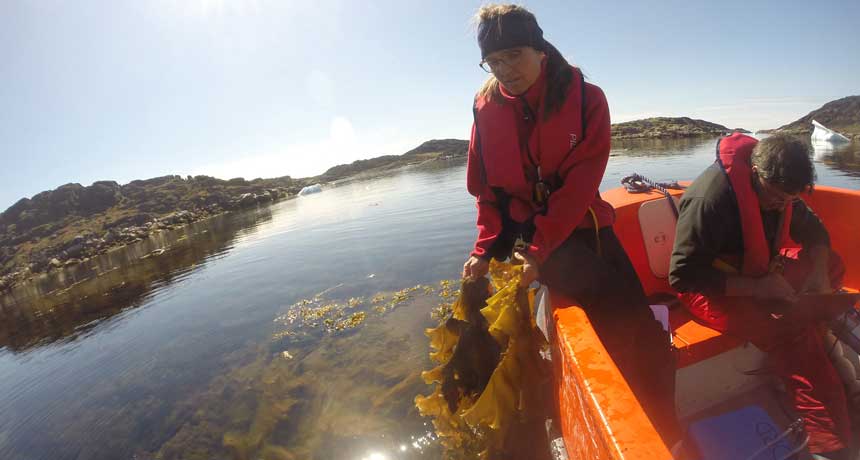Arctic kelp forests may create summer refuges from ocean acidification

During long summer days, kelp forests in high-latitude waters could create little safe zones for sea creatures in acidifying oceans, new research shows.
Sunlight stretching on for most or all of a day keeps kelps and other big algae working overtime, trapping solar energy through photosynthesis. In the Arctic, kelps pulled enough carbon dioxide from the surrounding seawater to nudge the local pH upward, monitoring showed. Seawater is generally alkaline instead of acidic, but in midsummer, kelp patches pushed the pH average even farther above acidity. In 10 days, average pH in an Arctic kelp patch in Greenland rose from 8.09 to 8.24, an international team of researchers reports December 14 in Science Advances. Follow-up lab tests of kelps suggest that 21 hours or more of sunlight per day should produce that refuge effect.
That local summertime bump bucks the general planetary trend of ocean surface water shifting closer to acidity. Carbon dioxide building up in the atmosphere isn’t just warming the planet; the notorious greenhouse gas dissolves in oceans, causing chemical reactions that drive seawater closer to becoming an actual acid.
“It’s a big concern,” says coauthor Dorte Krause-Jensen of Aarhus University in Denmark. Before the industrial revolution, the pH of seawater was about 8.2 but has now dropped to around 8.1. Even changes that look small on the pH scale can alter the ease of biochemical processes of life in the oceans.
Biologists are just beginning to grasp the complexities of these processes. But the shift in pH may make it harder for such organisms as snails, crabs and shrimps to draw calcium-building materials needed to form their shells out of seawater. Summertime might be a particularly important time for such species to get some relief, Krause-Jensen speculates. Those long days are often when new generations sheltering in the algae face heavy shell-building demands.
Sheltering forests of kelp and other hefty algae cluster here and there along coasts worldwide, but coastal studies of the effects of water acidity are a relatively new thing. The first wave of studies on biological consequences of ocean acidification focused on the open ocean, Krause-Jensen says.
Near-shore environments can be more complex than open water. There, photosynthesizing plants or algae take CO₂ out of water, so sea grass meadows and kelp forests cause daily rises and nightly falls in water acidity. This is the first study of pH in kelp forests in the Arctic, she says.
Krause-Jensen and colleagues monitored acidity in a stretch of Greenland’s Disko Bay where the wide, curvy, somewhat lettucelike leaves of kelps wave in the constant midsummer sunlight. There, the sun does not set between May 25 and July 17. The pH zigged and zagged during a 24-hour cycle, but overall the average rose. In comparison measurements farther south in the fall, when the sun shone for 15 hours, pH fluctuated but its overall average remained at 8.1.
To roughly mimic the coastal conditions in the lab, the researchers transplanted kelp species into small but realistically dense clusters in aquariums with different light regimens and baseline acidities. Acidity fluctuations showed up there, too, but overall the tests confirmed that the kelps can make their own trends in local seawater.
The notion that kelps might provide refuges or some kind of local relief from acidification is under widespread discussion. In Washington, the Puget Sound Restoration Fund is testing the idea with plantings of two kelp species. “It’s too early to tell whether kelp aquaculture will have a meaningful effect” in the sound, says marine ecologist Terrie Klinger of the University of Washington in Seattle.
Climate change might mean that kelps will find it easier to thrive in the Arctic, says Jarrett Byrnes of the University of Massachusetts Boston. While some predicted changes may increase risks, such as increasing runoff of smothering sediment from the coasts, dwindling sea ice may give kelps more sunshine. And that could provide more chances to create refuges for their neighbors.



